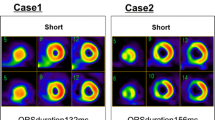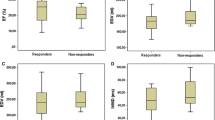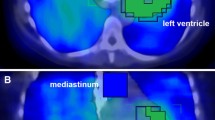Abstract
Purpose
Late ventricular potentials (LPs) are considered to be useful for identifying patients with heart failure at risk of developing ventricular arrhythmias. 123I-metaiodobenzylguanidine (MIBG) scintigraphy, which is used to evaluate cardiac sympathetic activity, has demonstrated cardiac sympathetic denervation in patients with malignant ventricular tachyarrhythmias. This study was undertaken to clarify the relationship between LPs and 123I-MIBG scintigraphy findings in patients with dilated cardiomyopathy (DCM).
Methods
A total of 56 patients with DCM were divided into an LP-positive group (n = 24) and an LP-negative group (n = 32). During the compensated period, the delayed heart/mediastinum count (H/M) ratio, delayed total defect score (TDS), and washout rate (WR) were determined from 123I-MIBG images and plasma brain natriuretic peptide (BNP) concentrations were measured. Left ventricular end-diastolic volume (LVEDV), left ventricular end-systolic volume (LVESV), and left ventricular ejection fraction (LVEF) were simultaneously determined by echocardiography.
Results
LVEDV, LVESV, LVEF and plasma BNP concentrations were similar in the two groups. However, TDS was significantly higher (35 ± 8 vs. 28 ± 6, p < 0.005), the H/M ratio was significantly lower (1.57 ± 0.23 vs. 1.78 ± 0.20, p < 0.005), and the WR was significantly higher (60 ± 14% vs. 46 ± 12%, p < 0.001) in the LP-positive than in the LP-negative group. The average follow-up time was 4.5 years, and there were nine sudden deaths among the 56 patients (16.1%). In logistic regression analysis, the incidences of sudden death events were similar in those LP-negative with WR <50%, LP-negative with WR ≥50% and LP-positive with WR <50% (0%, 10.0% and 14.3%, respectively), but was significantly higher (41.2%) in those LP-positive with WR ≥50% (p < 0.01, p < 0.05, and p < 0.05, respectively).
Conclusion
The present study demonstrated that the values of cardiac 123I-MIBG scintigraphic parameters were worse in LP-positive DCM patients than in LP-negative DCM patients. Furthermore, in LP-positive DCM patients with a high WR, the incidence of sudden death events was higher than that in other subgroups of DCM patients.





Similar content being viewed by others
References
Kjekshus J. Arrhythmias and mortality in congestive heart failure. Am J Cardiol. 1990;65(19):42I–8I.
Packer M. Sudden unexpected death in patients with congestive heart failure: a second frontier. Circulation. 1985;72(4):681–5.
Ikeda T, Sakata T, Takami M, Kondo N, Tezuka N, Nakae T, et al. Combined assessment of T-wave alternans and late potentials used to predict arrhythmic events after myocardial infarction. A prospective study. J Am Coll Cardiol. 2000;35(3):722–30.
Steinberg JS, Berbari EJ. The signal-averaged electrocardiogram: update on clinical applications. J Cardiovasc Electrophysiol. 1996;7(10):972–88.
Henderson EB, Kahn JK, Corbett JR, Jansen DE, Pippin JJ, Kulkarni P, et al. Abnormal I-123 metaiodobenzylguanidine myocardial washout and distribution may reflect myocardial adrenergic derangement in patients with congestive cardiomyopathy. Circulation. 1988;78(5 Pt 1):1192–9.
Schofer J, Spielmann R, Schuchert A, Weber K, Schluter M. Iodine-123 meta-iodobenzylguanidine scintigraphy: a noninvasive method to demonstrate myocardial adrenergic nervous system disintegrity in patients with idiopathic dilated cardiomyopathy. J Am Coll Cardiol. 1988;12(5):1252–8.
Merlet P, Valette H, Dubois-Rande JL, Moyse D, Duboc D, Dove P, et al. Prognostic value of cardiac metaiodobenzylguanidine imaging in patients with heart failure. J Nucl Med. 1992;33(4):471–7.
Nakata T, Wakabayashi T, Kyuma M, Takahashi T, Tsuchihashi K, Shimamoto K. Cardiac metaiodobenzylguanidine activity can predict the long-term efficacy of angiotensin-converting enzyme inhibitors and/or beta-adrenoceptor blockers in patients with heart failure. Eur J Nucl Med Mol Imaging. 2005;32(2):186–94.
Akutsu Y, Kaneko K, Kodama Y, Li HL, Kawamura M, Asano T, et al. The significance of cardiac sympathetic nervous system abnormality in the long-term prognosis of patients with a history of ventricular tachyarrhythmia. J Nucl Med. 2009;50(1):61–7.
Boogers MJ, Borleffs CJ, Henneman MM, van Bommel RJ, van Ramshorst J, Boersma E, et al. Cardiac sympathetic denervation assessed with 123-iodine metaiodobenzylguanidine imaging predicts ventricular arrhythmias in implantable cardioverter-defibrillator patients. J Am Coll Cardiol. 2010;55(24):2769–77.
Yamazaki J, Muto H, Kabano T, Yamashina S, Nanjo S, Inoue A. Evaluation of beta-blocker therapy in patients with dilated cardiomyopathy – clinical meaning of iodine 123-metaiodobenzylguanidine myocardial single-photon emission computed tomography. Am Heart J. 2001;141(4):645–52.
Toyama T, Hoshizaki H, Seki R, Isobe N, Adachi H, Naito S, et al. Efficacy of amiodarone treatment on cardiac symptom, function, and sympathetic nerve activity in patients with dilated cardiomyopathy: comparison with beta-blocker therapy. J Nucl Cardiol. 2004;11(2):134–41.
Simson MB. Use of signals in the terminal QRS complex to identify patients with ventricular tachycardia after myocardial infarction. Circulation. 1981;64(2):235–42.
Nalos PC, Gang ES, Mandel WJ, Ladenheim ML, Lass Y, Peter T. The signal-averaged electrocardiogram as a screening test for inducibility of sustained ventricular tachycardia in high risk patients: a prospective study. J Am Coll Cardiol. 1987;9(3):539–48.
Worley SJ, Mark DB, Smith WM, Wolf P, Califf RM, Strauss HC, et al. Comparison of time domain and frequency domain variables from the signal-averaged electrocardiogram: a multivariable analysis. J Am Coll Cardiol. 1988;11(5):1041–51.
Meinertz T, Hofmann T, Kasper W, Treese N, Bechtold H, Stienen U, et al. Significance of ventricular arrhythmias in idiopathic dilated cardiomyopathy. Am J Cardiol. 1984;53(7):902–7.
Schillaci G, Verdecchia P, Borgioni C, Ciucci A, Zampi I, Battistelli M, et al. Association between persistent pressure overload and ventricular arrhythmias in essential hypertension. Hypertension. 1996;28(2):284–9.
Schiller NB, Shah PM, Crawford M, DeMaria A, Devereux R, Feigenbaum H, et al. Recommendations for quantitation of the left ventricle by two-dimensional echocardiography. American Society of Echocardiography Committee on Standards, Subcommittee on Quantitation of Two-Dimensional Echocardiograms. J Am Soc Echocardiogr. 1989;2(5):358–67.
Kasama S, Toyama T, Kumakura H, Takayama Y, Ichikawa S, Suzuki T, et al. Effects of nicorandil on cardiac sympathetic nerve activity after reperfusion therapy in patients with first anterior acute myocardial infarction. Eur J Nucl Med Mol Imaging. 2005;32(3):322–8.
Kasama S, Toyama T, Kumakura H, Takayama Y, Ichikawa S, Suzuki T, et al. Effect of spironolactone on cardiac sympathetic nerve activity and left ventricular remodeling in patients with dilated cardiomyopathy. J Am Coll Cardiol. 2003;41(4):574–81.
Cerqueira MD, Weissman NJ, Dilsizian V, Jacobs AK, Kaul S, Laskey WK, et al. Standardized myocardial segmentation and nomenclature for tomographic imaging of the heart: a statement for healthcare professionals from the Cardiac Imaging Committee of the Council on Clinical Cardiology of the American Heart Association. Circulation. 2002;105(4):539–42.
Kasama S, Toyama T, Kumakura H, Takayama Y, Ichikawa S, Suzuki T, et al. Effects of candesartan on cardiac sympathetic nerve activity in patients with congestive heart failure and preserved left ventricular ejection fraction. J Am Coll Cardiol. 2005;45(5):661–7.
Kasama S, Toyama T, Kumakura H, Takayama Y, Ichikawa S, Suzuki T, et al. Effects of perindopril on cardiac sympathetic nerve activity in patients with congestive heart failure: comparison with enalapril. Eur J Nucl Med Mol Imaging. 2005;32(8):964–71.
Kasama S, Toyama T, Sumino H, Kumakura H, Takayama Y, Minami K, et al. Serial cardiac 123I-metaiodobenzylguanidine scintigraphic studies are more useful for predicting cardiac death than one-time scan in patients with chronic heart failure: sub-analysis of our previous report. Nucl Med Commun. 2010;31(9):807–13.
The CONSENSUS Trial Study Group. Effects of enalapril on mortality in severe congestive heart failure. Results of the Cooperative North Scandinavian Enalapril Survival Study (CONSENSUS). N Engl J Med. 1987;316(23):1429–35.
The SOLVD Investigators. Effect of enalapril on survival in patients with reduced left ventricular ejection fractions and congestive heart failure. N Engl J Med. 1991;325(5):293–302.
Cohn JN, Johnson G, Ziesche S, Cobb F, Francis G, Tristani F, et al. A comparison of enalapril with hydralazine-isosorbide dinitrate in the treatment of chronic congestive heart failure. N Engl J Med. 1991;325(5):303–10.
De Maria R, Gavazzi A, Caroli A, Ometto R, Biagini A, Camerini F. Ventricular arrhythmias in dilated cardiomyopathy as an independent prognostic hallmark. Italian Multicenter Cardiomyopathy Study (SPIC) Group. Am J Cardiol. 1992;69(17):1451–7.
Josephson ME, Horowitz LN, Farshidi A. Continuous local electrical activity. A mechanism of recurrent ventricular tachycardia. Circulation. 1978;57(4):659–65.
Poll DS, Marchlinski FE, Falcone RA, Josephson ME, Simson MB. Abnormal signal-averaged electrocardiograms in patients with nonischemic congestive cardiomyopathy: relationship to sustained ventricular tachyarrhythmias. Circulation. 1985;72(6):1308–13.
Denereaz D, Zimmermann M, Adamec R. Significance of ventricular late potentials in non-ischaemic dilated cardiomyopathy. Eur Heart J. 1992;13(7):895–901.
Schafers M, Wichter T, Lerch H, Matheja P, Kuwert T, Schafers K, et al. Cardiac 123I-MIBG uptake in idiopathic ventricular tachycardia and fibrillation. J Nucl Med. 1999;40(1):1–5.
Paul M, Schafers M, Kies P, Acil T, Schafers K, Breithardt G, et al. Impact of sympathetic innervation on recurrent life-threatening arrhythmias in the follow-up of patients with idiopathic ventricular fibrillation. Eur J Nucl Med Mol Imaging. 2006;33(8):866–70.
Yukinaka M, Nomura M, Ito S, Nakaya Y. Mismatch between myocardial accumulation of 123I-MIBG and 99mTc-MIBI and late ventricular potentials in patients after myocardial infarction: association with the development of ventricular arrhythmias. Am Heart J. 1998;136(5):859–67.
Tamaki S, Yamada T, Okuyama Y, Morita T, Sanada S, Tsukamoto Y, et al. Cardiac iodine-123 metaiodobenzylguanidine imaging predicts sudden cardiac death independently of left ventricular ejection fraction in patients with chronic heart failure and left ventricular systolic dysfunction: results from a comparative study with signal-averaged electrocardiogram, heart rate variability, and QT dispersion. J Am Coll Cardiol. 2009;53(5):426–35.
Bax JJ, Kraft O, Buxton AE, Fjeld JG, Parízek P, Agostini D, et al. 123I-mIBG scintigraphy to predict inducibility of ventricular arrhythmias on cardiac electrophysiology testing: a prospective multicenter pilot study. Circ Cardiovasc Imaging. 2008;1(2):131–40.
Conflicts of interest
None.
Author information
Authors and Affiliations
Corresponding author
Rights and permissions
About this article
Cite this article
Kasama, S., Toyama, T., Kaneko, Y. et al. Relationship between late ventricular potentials and myocardial 123I-metaiodobenzylguanidine scintigraphy in patients with dilated cardiomyopathy with mild to moderate heart failure: results of a prospective study of sudden death events. Eur J Nucl Med Mol Imaging 39, 1056–1064 (2012). https://doi.org/10.1007/s00259-012-2092-1
Received:
Accepted:
Published:
Issue Date:
DOI: https://doi.org/10.1007/s00259-012-2092-1




